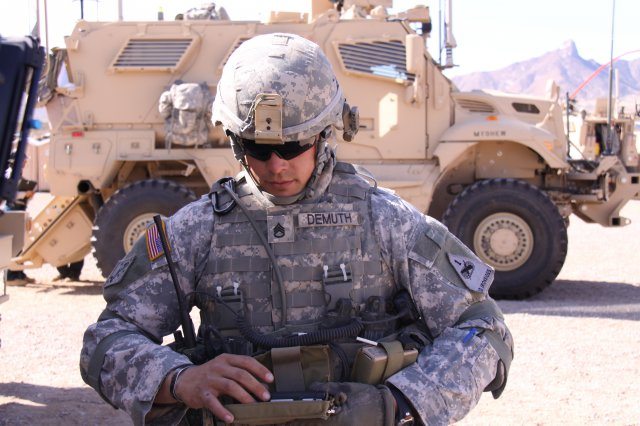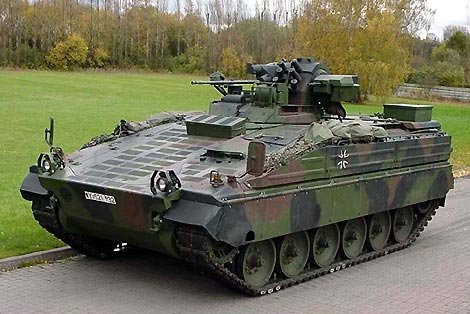An advanced lightweight radio that will connect troops on the front lines to the Army’s tactical communications network has completed its operational test.
The Joint Tactical Radio System, or JTRS, Rifleman Radio and its Soldier Radio Waveform, known as SRW, Network Manager component were the only systems under a formal program of record test at the recently concluded Network Integration Evaluation 12.1 here. While Soldiers from the 2nd Brigade, 1st Armored Division, also informally evaluated more than 45 other tactical communications systems, the Rifleman Radio test represents a key step toward fielding the Army’s future network.
The two-pound radio, which is carried by platoon, squad and team-level Soldiers for voice communications, can connect with handheld devices to transmit text messages, GPS locations and other data. Through SRW, it connects lower echelon Soldiers to one another and back to their leaders at the company level so they can rapidly exchange information.
“I use it for overall command and control because it builds a network that allows me to talk to my subordinate elements,” said Capt. Ryan McNally, a company commander within 2/1 AD who evaluated the Rifleman Radio at Network Integration Evaluation, or NIE, 12.1. “It’s the first time I’ve actually had radios down at the squad level. So my dismounted riflemen, they all have the radio as well. It allows them to talk to their team leaders when they’re spread out, and also allows them to talk to the squad leader.”
McNally said the ability to communicate with the radios instead of shouting or using hand-and-arm signals had altered his Soldiers’ tactical approach to their missions.
“We have to factor in being able to talk to each other over a distance, rather than everybody being essentially co-located with a limited amount of space and distance between them,” McNally said. “Now we can expand that space and distance. We can cover a larger area.”
McNally’s company used the radios in conjunction with handheld devices running Joint Battle Command-Platform software. JBC-P is the future version of the Army’s friendly force tracking and messaging system, known as Force XXI Battle Command Brigade and Below/Blue Force Tracking, known as FBCB2/BFT, which also allows users to plot hazards and enemy locations on a digital map. Plugged into the Rifleman Radio, these devices provided mission command and situational awareness information down to Soldiers at the tactical edge.
“They can get their grid (position) off of it, and they can see anybody else who has a Rifleman Radio,” McNally said. “You can send messages, create routes, drop a chem light (to show a building has been cleared), and send reports.”
During the test, the Army captured data on the radio’s performance in two ways: through instrumentation on the systems themselves, and through human data collectors who accompanied Soldiers throughout their missions.
“When they have a radio and they’re talking on it, I have a guy there that’s writing down information and talking to them, with specific questions that we’ve given them,” said test director Mike Nott.
He said the company formally testing the Rifleman Radio was physically isolated from the rest of 2/1 AD to ensure the integrity of the test, despite the complex NIE environment.
“Although they’re still part of the overall exercise and still in the scheme of maneuver, we physically separated them on the ground, and we did that on purpose,” Nott said. “We wanted to be able to control that battle space.”
The Army will evaluate those test results during the coming months, as it finalizes the makeup of its network Capability Set 13, which will begin fielding to up to eight brigade combat teams in fiscal year 2013.
The Rifleman Radio is part of the JTRS Handheld, Manpack, Small Form Fit, or HMS, family of radios. In June the HMS program achieved Milestone C, authorizing the Army to procure a low-rate initial production lot of up to 6,250 Rifleman Radios and up to 100 Manpack Radios. NIE results will help inform further purchasing decisions for the equipment.
The software-programmable JTRS radios, which can use encryption to safeguard information, are built to send Internet Protocol packets of data, voice, video and images via multiple waveforms between static command centers, vehicles on the move, and dismounted individual Soldiers on patrol. The JTRS waveforms, SRW and the Wideband Networking Waveform, known as WNW, are integrated with the satellite communications backbone of the Army network, Warfighter Information Network-Tactical, or WIN-T, to transmit that information on the upper tactical internet.
The Rifleman Radio is a key component to building the ground-level lower tactical network, bringing the most communication disadvantaged users — the small unit down to the individual user — into the network.
During NIE 12.1, Soldiers used the radios and handheld devices in a variety of realistic scenarios, including convoy operations, medical evacuation, reconnaissance and counterinsurgency. One 2/1 AD platoon leader, 2nd Lt. Travis V. Mount, said the technology showing the positions of his troops allowed him to save time by immediately adapting and executing his plans rather than tracking down personnel first.
“No matter what kind of organization you’re running, if you have dismounts who are going to be on the ground you like to be able to see where your personnel are,” Mount said. “If all I need is information on their position, I don’t have to go through an intermediary. I can on the spot adapt my plan.”
He said the Tactical Ground Reporting, known as TIGR, software application running on the handhelds was also valuable for sharing patrol information such as routes, places and people of interest.
“Instead of having to go to the Tactical Operations Center at the end of the day to download the information on the events and observations, I can either (do it in) real time or when I have a lull in the mission,” Mount said. “I can just plug it in right there.”
(Ashley Blumenfeld, JPEO JTRS, contributed to this report.)











